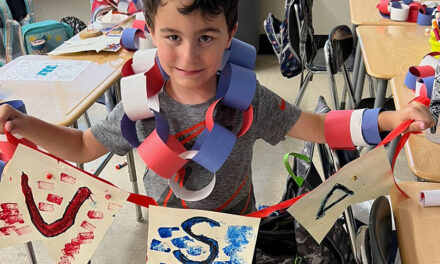Published June 16, 2021
By DAN TOMASELLO
LYNNFIELD — A group of Lynnfield Middle School eighth-graders urged the School Committee to completely overhaul the district’s dress code policy during a June 8 meeting.
Eighth-grader Ella Hayman, who is the daughter of School Committee member Jamie Hayman, along with close friends Emma Rose and Maeve Donovan told the school board that the district’s dress code policy for all four schools is unfair toward girls and is unequally enforced. Superintendent Kristen Vogel and Middle School Principal Stephen Ralston recently met with the three friends and a group of other young women in order to discuss updating the dress code policy.

The three friends also created a video that featured a group of girls giving an overview of how the school system’s dress code policy and its enforcement are discriminatory and unequal.
“Me and many of my friends have experienced issues with the dress code over the last four years,” said Ella. “We are not alone. What inspired us to come to you was an incident in class surrounding the dress code. Many of us were in class recently, and a teacher told these girls in the class that they needed to cover up because it was a coed class and just because it was getting warmer doesn’t mean we should wear more revealing clothes.”
Ella said the teacher told the two girls that “they needed to change or cover up.”
“Neither of the girls were wearing anything inappropriate,” said Ella. “The issues with the dress code are unequal enforcement, the fact that it is directed at girls, whether clothing should be considered distracting, the current styles as they relate to the dress code and the fact it sends a negative message to girls. We also feel that if someone is called out for dress code reasons that it should be done in private.”
Emma said the dress code enforcement policy is “inequitable.”
“The current dress code as is written is unfair towards female students,” said Emma. “It is also unfairly enforced. For example, a male peer wore a white tank top to school at least two times this spring. A teacher did not ask him to cover up or change, and he was allowed to wear the tank top both days. However for female students, clothing needs to be examined in front of other classmates and girls are still being asked to cover up if they are wearing similar tank tops to school.”
During a class in April, Emma said a teacher “called out” a girl for wearing a shirt that was “distracting.”
“This student’s shirt was not inappropriate or distracting to anyone,” said Emma. “The student in question was asked to put something on to cover that up. That kind of language makes female students feel self-conscious and embarrassed in front of our peers. Female students, like male students, are at school to learn and grow. Girls should not have to worry whether or not our outfits are disrupting the educational process of our male peers. Maybe there should be a discussion about appropriate behavior of all students in school and not just focus on girls’ clothing?”
Maeve said the middle school’s handbook policy prohibits students from wearing tank tops, skirts and shorts that are shorter than mid-thigh.
“Tank tops and shorts are the most comfortable things to wear during the first few and last few months of the school year since the second floor doesn’t have air conditioning,” said Maeve. “Saying shorts must be worn up to mid-thigh is not fair. Many people have different body types and different leg lengths.”
Eighth-grader Ciara Long said having teachers tell girls to cover up “sends a bad message.”
“They are basically being told that they should cover up and if they don’t, it will be their fault that people are distracted by them,” said Ciara. “The dress code that is currently being enforced is teaching girls as young as 10-years-old that their bodies are a distraction. When girls in the fifth grade and older are told constantly to stay covered and dress more modestly, it can make them feel self-conscious about their bodies. If the dress code were to be changed so it is fair to everyone, then everyone will be included and no one would have to be singled out because of their gender.”
If a student violates the dress code policy, eighth-grader Lily Rocco said teachers should discuss the issue with students privately instead of calling them out in front of the entire class. She recalled that she was called out for violating the dress code during gym class.
“My face got really red,” said Lily. “I was really embarrassed and felt insecure. I wasn’t thinking about the dress code in that moment. I was thinking about what people thought of me. If a teacher is going to tell a student they are breaking the dress code, the teacher should tell the student politely at the end of class when no one is watching them. It can be really embarrassing if you get called out in front of everyone.”
Eighth-grader Bella Shrewsbury said the dress code should be changed because “it is mainly directed at girls.”
“It doesn’t apply to all,” said Bella. “Most boy shirts are longer and they don’t typically wear tank tops. The short requirements are way too long. No one wears shorts that are that long.”
Eighth-grader Ellie Grieves said it is difficult to find clothes that adhere to the dress code policy.
“It seems that teachers all have different ideas of what it actually is,” said Ellie. “Some teachers enforce it more extremely than others. Clothing is a way for people to express themselves, and no one should be forced to wear something that brings down their confidence. Students should be able to wear whatever they please under less strict guidelines.”
After the video concluded, the students were given a round of applause. Ella, Emma and Maeve also presented a proposed draft of the revised dress code policy to the School Committee.
“It is expected that students will take pride in their personal appearance,” the policy draft states. “Student dress should be within reasonable limits and should not be extreme. Personal appearance, dress or grooming must not disrupt the educational process or threaten the health or safety of any individual. The administration has the right to ask students to change their attire if it disrupts the educational environment.”
The policy draft continues: “Clothing which could create an actual disruption or disorder to the learning environment includes but is not limited to: Clothing or jewelry that displays slogans, insignias or designer that advertise alcohol, drugs or sexual material which promote products or activities that are illegal, profane or suggestive. Clothing or jewelry, which is disparaging to others in the school environment and contains slurs regarding race, ethnicity, religion, disabilities or sexual orientation. Hats and hoods should not be worn while in the school building (exceptions for medical, religious, cultural reasons or special circumstances).”
Additionally, the dress code policy change seeks to prohibit students from wearing “underwear as outerwear, beachwear and sleepwear.”
“Repeated violations of the dress code will result in consequences,” the policy draft concludes.
SC expresses support
School Committee Chairman Rich Sjoberg expressed his support for changing the district’s dress code policy.
“I have been a member of this committee for five years,” said Sjoberg. “The increase in students advocating for themselves is something that all students in Lynnfield should be proud of. I am moved that you have put this together and you took the time to put that video together to present this to us.”
Sjoberg asked Ella, Emma and Maeve if the Policy Subcommittee could take a copy of the revised dress code policy proposal in order to review it.
“We will review it over the summer and then come back before the start of the next school year in order to see what adjustments and alignments we can change,” said Sjoberg.
School Committee Vice Chairwoman Stacy Dahlstedt, who serves on the Policy Subcommittee with Sjoberg, applauded the three young women for creating the video and the revised policy draft.
“We will definitely consider updating the policy,” said Dahlstedt. “But another point that was made in the video was the actual enforcement of the policy. We want to make sure there is consistency. If someone is called out, it should be done discretely. Thank you for bringing this to our attention.”
School Committee member Kate DePrizio commended the three friends for raising awareness about the problems associated with the dress code.
“Your video was articulate, concise and thoughtful,” said DePrizio. “It was really powerful because other girls, peers and adults will hear you and will think about how we talk about clothing and bodies. I thought it was tremendous.”
School Committeeman Phil McQueen agreed.
“I want to congratulate you for identifying how the dress code is archaic and sexist,” said McQueen. “I want to thank you for bringing it to our attention so we can change it.”
School Committee member Jamie Hayman was full of pride while watching his beloved Ella and her two friends push for changes to the dress code policy.
“I have know one of these girls for her whole life and the other two since kindergarten,” said Hayman. “I am very impressed with what they have done. I want to thank Superintendent Vogel for helping them through this process. There were many more girls involved in this process. There were middle school and high school students involved. Everyone did a great job.”
Ella, Emma and Maeve thanked the School Committee for listening to their presentation. All three young women were given a round of applause at the end of the presentation.




